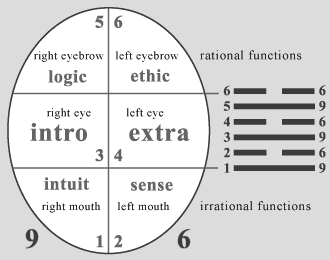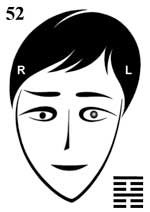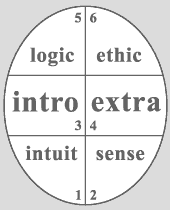The analytical physiognomy unites analytical psychology and psychophysiology
of a brain with physiognomy. According to principles of analytical physiognomy
it is possible to speak about ratio of features of a human face with functions
of hemispheres of a brain, and also with concepts of analytical psychology which
were formulated by C. G. Jung (Carl Gustav Jung).
Namely if to look at a human face then in most cases it is possible to see
asymmetry of the right half and the left half that is caused by different
psycho-physiological functions of hemispheres of a brain. Functions of the left
hemisphere are projected on the right half of face, and functions of the right
hemispher are projected on the left half of face, and accordingly agrees to
features of the right half of face it is possible to speak about functions of
the left hemisphere of a brain, and according to features of the left half of
face it is possible to speak about functions of the right hemisphere of a brain.
And also according to features it is possible to speak about psychological
properties of a human person as the human psychology is connected to functioning
hemispheres of a brain. In essence it is possible to correlate concepts of
analytical psychology of C. G. Jung to physiognomy of a human face as functions
of hemispheres of a brain and the appropriate psychological properties have
physiognomic projections.
Rules of analytical physiognomy consist in the following.
Eyes specify the basic psychological direction of a person which can be
extraverted or introverted.
Extraverts have an active left half of face and an active left eye, and
introverts have an active right half of face and an active right eye
provided that an active half of face less rather than a
passive half of face, and an active eye more open and bright rather than
a passive eye.
Psychological direction of a person of extraverts is focused in external world
and depends on external world. Psychological direction of a person of introverts
is focused in own private world and does not depend on external world.
The used terminology corresponds to concepts of analytical psychology which
are formulated by by C. G. Jung (Carl Gustav Jung) in the book "Psychological
types" and consequently the given psychological definitions should be understood
in a context of formulations of by C. G. Jung.
Within the extraverted or introverted direction
of a person there is a realization of mental functions which
are specified by eyebrows and a mouth, namely eyes are physiognomic
projections of psychological directions of a person, and eyebrows and mouth are
physiognomic projections of mental functions from the point of view of
analytical physiognomy.
The left eyebrow specifies ethical mental function.
C. G. Jung named this function as emotional (feeling), but emotions are
mental processes which in essence are not mental functions and consequently
truly to name this function as ethical.
The ethical type of a person understands ethical relations of
people, understands sympathy which finds out in individual moods of
people.
The right eyebrow specifies logic mental function.
C. G. Jung named this function as cogitative (thinking), but the thinking
is a process of activity of a brain as a entire and consequently truly to name
this function as logic.
The logic type of a person establishes logic orders and systematizes
laws of the world, and also analyzes the facts.
Ethical and logic functions are rational (judging) i.e. these
functions are subordinated to consciousness and correspond with the top half of
face. Two following mental functions are
irrational (perceiving) i.e. these functions are submitted to feelings (sensual perceptions)
and correspond with the bottom half of face.
The left corner of a mouth specifies sensory (touch-sensitive)
mental function.
The sensory type of a person perceives perceives the world by means of
sensations and touch contact to subjects and objects.
The right corner of a mouth specifies intuitive mental function.
The intuitive type of a person has uncertain sensations and consequently
perceives subjects and objects of the world in the abstract.
The term "intuition" cannot be understood in everyday value, namely
usually the intuition means an incomprehensible guess which arises
during thinking, but in a context of analytical psychology the intuition
is an irrational mental function which does not submit to rational
comprehension.
Thus, hemispheres of a brain determine psychological parameters of a human person,
and psychological parameters are projected on the right and left half of a face
that allows to apply methods of physiognomy during testing and identification of
psychological types in analytical psychology.
Various ratio of psychological parameters can be systematized by means of 64
hexagrams of the canon of changes IChing as features of a human face have
conformity with the canon IChing, that is shown on the chart where
positions of lines in hexagrams IChing conditionally are compared to features of a
human face, and also are compared to mental functions and psychological
directions of a human person:
 |
The sequence of lines in hexagrams IChing is directed
from below upwards, namely the bottom position is the first and the top
position is the sixth. The left eyebrow corresponds to the 6th position and specifies ethical function; the right eyebrow corresponds to the 5th position and specifies logic function; the left eye correspond to the 4th position and specifies the extraverted direction of a person; the right eye corresponds to the 3rd position and specifies the introverted direction of a person; the left corner of a mouth corresponds to the 2nd position and specifies sensory function; the right corner of a mouth corresponds to the 1st position and specifies intuitive function, that is shown on the chart in the Arabian figures. |
The left half of face and the left eye correspond to extraversion, and the
right half of face and the right eye correspond to introversion, and
consequently positions of the left half are pertinent for the break lines
in hexagrams IChing, which symbolize an orientation in an external world, and
positions of the right half are pertinent for the entire lines in hexagrams IChing, which symbolize an orientation in a private world. Namely the left half
of face is pertinent for the break lines to which there corresponds
numerological number 6, and the right half of face is pertinent for the entire
lines to which there corresponds numerological number 9 in a context of Chinese
numerology, that
also is shown on the chart in the Arabian figures.
Look the detailed information on pertinent and inappropriate positions of lines in
hexagrams IChing, and also the information on ratio of numerological numbers
of Chinese numerology with hexagrams IChing on pages of this site in the other
section:
concepts of a canon of changes.
According to lines in hexagrams IChing the adjacent psychological parameters
are obvious/unobvious or active/passive. Namely the left eyebrow and the right eyebrow
have
adjacent 5th and 6th positions, the left eye and the right eye have adjacent
3rd and 4th positions, the left corner of a mouth and the right corner of a
mouth have adjacent 1st and 2nd positions. If adjacent positions correspond with identical lines
in hexagrams then the appropriate psychological parameters are obvious
or unobvious, provided that parameters are obvious if corresponds
with pertinent lines, and parameters are unobvious if corresponds with inappropriate lines in hexagrams IChing. If adjacent positions
correspond with unequal lines in hexagrams then the appropriate psychological parameters are
active or passive, provided that parameters are active if corresponds with break lines, and
parameters are passive if
corresponds with entire lines. Namely extraverted and introverted directions of a
human person, and also irrational and rational pairs of mental functions are
interdependent and consequently are obvious or unobvious if the appropriate
adjacent positions correspond with identical lines, and are active or passive
if the appropriate adjacent positions correspond with unequal lines in
hexagrams IChing.
For example, two entire lines on adjacent 5th and 6th positions specify evidence
(obvious) of logic function and not evidence (unobvious) of adjacent ethical
function, but two break lines specify evidence (obvious) of ethical
function and not evidence (unobvious) of logic function. Different lines on 5th
and 6th positions specify activity and passivity of these functions, namely
specify active logic function and passive ethical function if the entire line is
on 5th position and the break line is on 6th position, or specify active
ethical function and passive logic function if the entire line is on 6th position
and the break line is on 5th position.
Obvious/unobvious and active/passive are linguistic definitions which by
means of expressionism of words express various parities of adjacent mental
functions and directions of a human person, and also express physiognomic displays
which literally mean visual obvious/unobvious or activity/passivity of facial
features to which mental functions and directions of a human person are
compared.
According to concepts of C. G. Jung's analytical psychology adjacent
psychological parameters are mutually exclusive, that is two irrational
functions are incompatible or two rational functions are incompatible in one
person, namely logic function is not shown together with ethical function and
sensory function is not shown together with intuitive function, and also the man
can not be simultaneously introverted and extraverted. But such concepts of
analytical psychology are not authentic as actually adjacent psychological
parameters can be combined, that is logic and ethical functions, or intuitive
and sensory functions can be shown equally, and also extraversion and
introversion can be shown equally. Namely when features of the right half and
the left half of face are symmetric then psychological parameters are combined
and shown equally, and only in the event that features of a of face are
asymmetric then the appropriate psychological parameters are mutually exclusive.
Accordingly definitions active/passive express psychology of of a human person
in which active parameters exclude passive parameters, and definitions obvious/
unobvious express balance. That is one of adjacent parameters prevails as a
result of asymmetry, and unobvious parameter is combined with adjacent obvious
parameter as a result of symmetry. Namely
definitions active/passive express mutually exclusive property of adjacent
mental functions and directions of a person, and also express asymmetry of the
right half and the left half of face. Definitions obvious/unobvious express
balance of adjacent mental functions and directions of a person, and also
express symmetry of the right half and the left half of face. As a result of
asymmetry one of adjacent parameters prevails, but as a result of symmetry the
adjacent parameters are harmonized (mixed), and unobvious psychological
parameter is given in harmony with obvious psychological parameter.
Also physiognomic images in gallery correspond to symmetric and asymmetric
features of the right half and the left half of human face. Active features are
represented as joyful (vigor), and passive features are represented as sad (unvigor).
The active half of face has the smaller size, and the passive half of face has
the greater size. The active eye is represented as more open and has a light
stain in the centre of a pupil that means brightness of an active eye, namely
means that the active eye draws attention. The passive eye is represented as
less open and has no light stain.
Obvious features of the right half of face are similar to images of passive
features, and obvious features of the left half of face are similar to images of
active features. That is obvious psychological parameters of the right half of
face correspond to sad unvigor features and less open image of an eye, and
obvious psychological parameters of the left half of face correspond to joyful
vigor features and more open image of an eye. Images of unobvious features are
identical to adjacent obvious features.
For example, the physiognomic image which corresponds to the 52nd hexagram
IChing:

 |
The left half of face is designated by letter L, and
the right half of face is designated by letter R, namely physiognomic
images in gallery are shown as a face of the man before a face of the
observer. 6th position (left eyebrow) - passive ethical function. |
Adjacent 5th and 6th positions correspond with different lines in
hexagram IChing and consequently the entire line on 6th position corresponds to
passive ethical function that is represented by means of the unvigor left
eyebrow, and the break line on 5th position corresponds to active logic
function that is represented by means of the vigor right eyebrow.
Adjacent 3rd and 4th positions correspond with different lines in in
hexagram IChing and consequently the break line on 4th position
corresponds to active extraversion that is represented by means of more open
left eye, and the entire line on 3rd position corresponds to passive introversion
that is represented by means of less open right eye.
As if adjacent positions correspond with different lines then the
psychological parameter is active to which there corresponds the break
line, and the psychological parameter is passive to which there corresponds the
entire line.
Adjacent 1st and 2nd positions correspond with identical lines in in
hexagram IChing, and the line on 2nd position is pertinent as the left half of
face is pertinent for the break lines and consequently the kind of the
left corner of a mouth is vigor that corresponds to obvious sensory function.
And the line on 1st position is inappropriate as the right half of face is
inappropriate for the break lines and consequently the right corner of a
mouth is identical to the left corner of a mouth that corresponds to unobvious
intuitive function.
As if adjacent positions correspond with identical lines then the
psychological parameter is obvious to which there corresponds a pertinent line,
and the adjacent psychological parameter is unobvious to which there corresponds
an inappropriate line. And also as vigor (active) images correspond to obvious
features of the left half of face, and unvigor (passive) images correspond to
obvious features of the right half of face. And also images of unobvious
features are identical to adjacent obvious features.
It is necessary to tell that so complex visual system for ratio of psychological
parameters with features of a human face is necessary in the shown images, as in
images there are conditionally displayed valid physiognomic attributes according
to which it is possible to test faces of real people.
More detailed information on testing and identification of psychological types
by means of the physiognomic analysis of human faces look on pages of this site
in the other section which has the name analytical
physiognomy.
The following page describes charts which are shown in gallery alongside with physiognomic images. And also gives comparison of offered system of 64 psychological types in analytical physiognomy with system of 16 psychological types in socionics and I. Brigs-Majers's typology which are derivatives from C. G. Jung's analytical psychology.